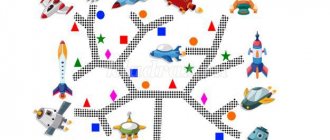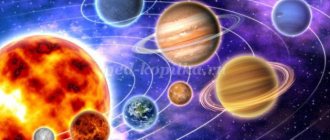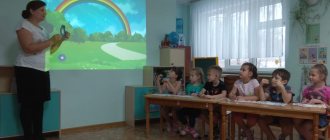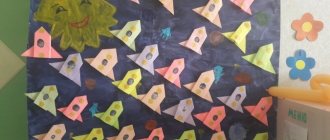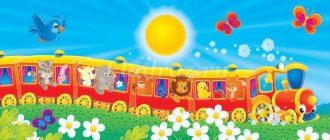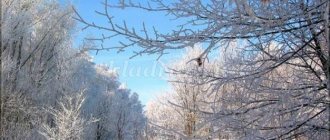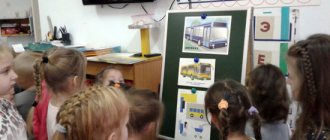Lesson for the senior group on the topic: “Travel into space”
Purpose: Familiarization with the planets of the solar system. Expanding knowledge and ideas about space and the profession of astronaut. Objectives: - Creating conditions for the formation of children’s elementary ideas about space. — Create a friendly atmosphere and positive emotions in children.
— Develop a sense of collectivism, the ability to play in groups.
— Improve the ability to establish the sequence of the day: morning, afternoon, evening, night. — Exercise the ability to move in a given direction (rotation, back and forth). Develop thinking. Expand words knowledge. Expand children's understanding of the planets of the solar system, the profession of astronaut, and the personal qualities of an astronaut. Develop cognitive interest, attention, memory, imagination, creativity. Equipment: projector and screen for presentation, flashlight, rocket model, solar system model, globe, hoop, yellow ball, small blue ball, water, solar system planet banner, “Starry Sky” night light, “Young Cosmonaut” emblems. Methods and techniques: gaming, visual, practical, verbal. Enrichment of vocabulary: cosmodrome, weightlessness, expedition, satellite, spacesuit, airship, airplane, planets of the solar system Health-saving technologies: relaxation break (imitation of sun rays), outdoor games. Surprise moment: The effect of the starry sky, interaction with teachers - they are in the role of aliens. Outdoor games “Weightlessness”, “Sunshine”, “Sun and Rain”. Presentation "Space Expedition".
Progress of the lesson:
Children to the song “Fly to the sun and return home quickly.” enter the hall.
Educator : Hello, guys. My name is Muminat Alibekovna. Look, guys, how many guests we have today. Are you happy to have guests? (Yes.) Then let's smile at them and welcome our dear guests. (Hello.) Guys, do you like to travel? (Yes.) Today we will go on an unusual space expedition and get acquainted with the planets of the solar system. Let's find out the sun moves around the earth or the earth around the sun. Why is there day and why is there night? And many, many interesting things. Let's sit down on the path. And before we go on Space Expedition, let's talk about space. What is space? (Children's answers.)
This is a starry sky. (Slide.) It is high, high. This is a system of planets. (Slide.) This is the moon with the earth. (Slide.) But this is the sun. (Slide.) Guys, tell me, is the sun a star or a planet? (Children’s answers. Slide.)
People have looked at the sky and dreamed of flying for a long time. First they flew in a hot air balloon, and then they flew in airships, in airplanes, then in airplanes and helicopters. But their dream did not leave them to rise even higher, into space. Then the first artificial satellite was launched into space. Please see what he looked like. Then a second space satellite was launched, but with a living creature. And who were these living beings? (Children's answers.) Why were dogs sent into space first? (Children's answers.) Look, guys. Slide
This is Belka and Strelka. Before they were sent into space, they were trained for a long, long time and they landed safely on the ground. Special spacesuits and helmets were made for them. Guys, what is a spacesuit? (Children's answers.) Slide.
But look what the spacesuit looks like? (Slide.)
Where do space rockets start from? (Children's answers.) Slide
Guys, a very, very long time ago, when not only your mothers and fathers were not yet, but your grandparents were not yet there, when your great-grandmothers and great-grandfathers were almost the same as you are now, the first person flew into space. Do you know who? (Children's answers.) Cosmonaut Yu. A. Gagarin. Please look at the screen.
In a space rocket called “Vostok” He was the first on the planet to rise to the stars.
He made one revolution around the earth. Spent 1 hour and 48 minutes in space.
And since then, on April 12, our country has been celebrating Cosmonautics Day.
What should an astronaut be like? (Children's answers.) Some of you too may become an astronaut. Girls can become astronauts too. Who knows the first woman astronaut? (Children's answers.) This is Valentina Tereshkova. (Slide.)
For what purpose does an astronaut fly into space? The astronaut is given a task and he completes it. And we have a task to learn about the planets of the solar system, how the Earth rotates. But before we go into space, I need to check your physical fitness. Don't yawn around - We are astronauts today! Let's start training to become strong and agile!
Exercise: “Swing-carousel and sat on a rocket”
To become an astronaut you need to train for a very long time, astronauts train on special simulators, and we train on a swing.
Children stand in a circle and begin to spin around themselves. - Swings, carousels, you and I sat on a rocket! Children go to the center of the circle and raise their hands up. Perform several times.
Educator: Well, now, guys, we can safely go on a flight in our spaceship, and you and I will fly into outer space. Well, where is our cosmodrome? Let's go guys.
The children enter the decoration ship and take their seats.
Educator: Fasten your seat belts. The devices were turned on. Let's start the countdown: 5,4,3,2,1 start!
Educator: Let's go! Slide video “Rocket flies into space” Look through your windows at the beauty of space!
Watching the film “Planets of the Solar System.” Educator: We are in outer space, I suggest you go into outer space.
Exercise: “Weightlessness.”
When you're in space, my friend. Miracles are happening all around. Look, this is news - After all, this is weightlessness.
(Children perform movements as if they are in zero gravity.)
Educator: Guys, look around, look. Someone is looking at us. Who is this? Yes, these are aliens. Let's say hello to them. Let's wave our hands at them.
And now guys, I invite you to the space laboratory. Guys, please look, these are the planets of the solar system. Please name which planets you remember. Try to find them here.
(Children name the planets they remember and show them. The teacher helps them if help is needed.)
Educator: Look, guys, in our universe, if we see such a sun, then the earth will be the size of this pea. Look how small she is. Take it, hold your planet in your hands. Pass it on to each other. Be careful not to drop it, because you are now holding our land in your hands.
Physical minute: In the morning the sun rises higher and higher, (stretch up). In the evening the sun sets lower and lower. (sit down)
(We repeat several times.) Educator: Guys, is this so? Let's check! Guys, sit down on the chairs. Guys, what is this? (Shows the globe.)
(Children's answers.) Correct. A globe is a model of the earth. The earth makes one revolution around its axis every 24 hours. And when the sun illuminates one side of the earth, it is day on that side. (We illuminate the globe with a flashlight.) And the next day it’s night. Day and night are days. What is a year? (Children's answers.) The earth makes one revolution around the sun in 365 days. This is the year. Earth's satellite is the Moon. The Moon is turned to the Earth on one side. It reflects the light of the sun, like a sunbeam. The Moon revolves around the Earth, and the Earth revolves around the Sun. Sometimes the Moon is not round, then it is called the Moon. To find out whether it is decreasing or increasing, you need to mentally insert a wand. If the letter P is increasing, if Y is decreasing. Teachers in the role of Aliens. Educator: Dear Aliens, do you agree with us? (They have eyes drawn on their hands and they seem to blink with them.)
Children in the role of the Earth and the Moon revolve around the sun.
Educator: Last July, an important cosmic event took place - a parade of planets. What is a parade? (Children answer.) ... people are walking, carrying banners, flags, balloons. And we will give our planets banners with numbers. (Children in the role of planets revolve around the sun, they have the number of the planet in their hands.) Educator: 1,2,3,4,5 - planets, stand in a row! Children line up in a row. Educator: Dear Aliens, do you like it? (Question to colleagues.) Well done guys! Guys, look, the sun without rays is not very beautiful. Let's turn into rays of sunshine ourselves. Lie down on the floor, hold hands. Feel each other's warmth. Raise your arms up, legs up, lie down, relax, and for now I’ll tell the sun about life on Earth. Close your eyes. The sun gives us such phenomena as sunset and sunrise. For us, sunrise is like the beginning of something new, and sunset is a wonderful phenomenon of beauty and mystery. On Earth we have rain (spray water on the children), and there is a light breeze (blow). Sunny, can you feel the touch of the rain and the breeze? (The children lie quietly, the “starry sky” lamp turns on, and the light turns off for a while.)
Open your eyes and admire space! (The lamp shines on the ceiling. Calm music plays.)
You see guys: the star has fallen. Make a wish.
Educator: guys, the time of our expedition is coming to an end.
Did you enjoy our expedition? (Children's answers.) Guys, it's time for us to return to earth. We take our seats in the spaceship.
So, countdown: 54321 launches!
The rocket returns to earth. The children leave the ship.
Educator: Guys, when astronauts return to earth after being in weightlessness for a long time, they even stop walking and they undergo a rehabilitation course and perform various exercises. Let's all stand in a circle and turn our backs to each other. Since we were also in zero gravity for a long time and have just returned from a flight, we will also do exercises. You draw on your friend’s back with your index finger what I will tell you. Draw a big sun with your finger. Guys, we will draw and walk slowly. The rays are leaving from the sun. The sun is shining. Suddenly a cloud appeared. It began to rain. Tap your finger on the back. The cloud appeared again. And the sun came out again. It shines brightly. Well done boys. So we completed the rehabilitation course. Guys, you liked the lesson. What did you like or remember most? (Children's answers.)
We all did a great job, and that’s why I’m awarding you the “Young Cosmonaut” medals. Thank you very much everyone.
Senior group. Senior preschool age. Children 5-6 years old
Abstract of GCD for children of senior preschool age “Space. Solar system" Abstract of GCD on the topic " Space . Solar system"
for children of senior preschool age Goal: To develop cognitive interest in children in the study
of space and the solar system.
Objectives: To form ideas about the planets of the solar system, their features, location... Abstract of an open educational activity for children of senior preschool age with STD "Cosmos" OPEN DIRECT EDUCATIONAL ACTIVITY for children of senior preschool age in the compensatory group with STD (severe speech impairments)
On the topic:
“
Space ” Developers: educators Speech therapist Teacher Correctional and educational goals. Formation…
Space. Lesson notes – Lesson notes on speech development in the senior group “Cosmos”
Publication “Summary of a lesson on speech development in the senior group...” Full name of the participant: Lyudmila Sergeevna Kotegova Educational areas: speech development Topic of the lesson: Space Age group: senior group (5-6 years) Purpose of the lesson: developing children’s knowledge about space and solar planets systems. Objectives of the lesson: To develop an interest in space,…
Summary of the lesson “Journey into Space” for children of the senior group Summary of continuous educational activities Educational area “Artistic and aesthetic development” Section “Drawing” on the topic: “Journey to Space”. for older children age (5 – 6 years old) Topic: “Travel into space.” Goal: Determination of knowledge and skills...
Summary of an educational event for children 6 years old “Journey through the Universe” Municipal budgetary institution of additional education Center for the Development of Creativity of Children and Youth “Winged” Topic: “Comic Journey through the Universe” Age of children: 6 years Author: methodologist, Yulia Sergeevna Shinkarenko Explanatory note. Educational event...
Summary of GCD in the form of a quest game for children of senior preschool age “Journey to Space” Summary of GCD in the form of a quest game for children of senior preschool age “Journey to Space” Purpose of the game: To develop children’s interest in space. • introduce children to the first cosmonaut to fly into space in South Africa. Gagarin; • consolidate children’s knowledge that they live on the planet...
